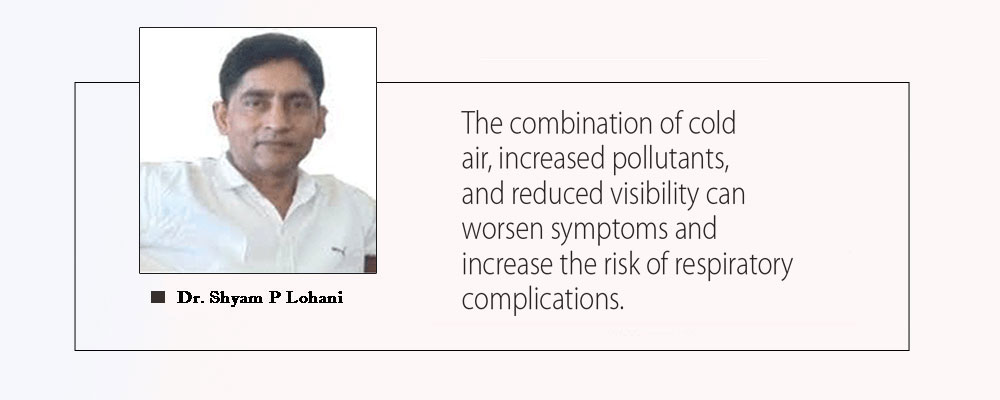- Saturday, 25 October 2025
Winter Fog Harmful For Pulmonary Patients
As winter descends upon us, so does the thick blanket of fog that often engulfs our surroundings. While fog can create a picturesque ambiance, it also poses significant risks to our daily lives. To ensure our safety and well-being during this season, it is crucial to adopt preventive measures that mitigate the hazards associated with winter fog. During winter, the tranquil beauty of foggy mornings can be enchanting. However, for individuals living with respiratory ailments such as Chronic Obstructive Pulmonary Disease (COPD) and asthma, winter fog can pose serious health risks.
Winter fog is a common occurrence in many parts of the world during the colder months. While it may create a beautiful, serene atmosphere, it can also have negative effects on our health, particularly our respiratory system. Fog is essentially a cloud that forms at ground level, and it is made up of tiny water droplets. When we breathe in foggy air, these droplets can enter our respiratory system and cause irritation and inflammation. This can lead to respiratory illnesses such as bronchitis, asthma, COPD, and pneumonia.
Risks
COPD is a chronic lung disease that affects millions worldwide, and the combination of cold weather and foggy conditions can exacerbate symptoms and increase the risk of respiratory complications. Asthma is characterised by inflammation and narrowing of the airways, which can cause wheezing, coughing, and difficulty breathing. Winter fog can exacerbate these symptoms, making it harder for people with asthma to breathe. The impact of winter fog on COPD and asthma patients can be devastating. Winter fog is characterised by low visibility and high levels of moisture in the air. These conditions can have a detrimental effect on individuals with COPD and asthma for many reasons.
Poor air quality results when fog traps pollutants close to the ground. This can exacerbate respiratory conditions such as asthma, bronchitis, and COPD. The fine particles in fog can also penetrate deep into the lungs, causing inflammation and respiratory distress. This is particularly concerning in urban areas, where there are higher levels of pollution to begin with.
Foggy weather often leads to increased levels of airborne pollutants, such as particulate matter and allergens. In addition, winter fog often contains high levels of pollutants, such as nitrogen oxides and sulfur dioxide, which can also worsen respiratory symptoms. These pollutants can irritate the airways, triggering inflammation and causing breathing difficulties for respiratory patients. Winter fog can exacerbate these symptoms, making it harder for people with chronic respiratory illnesses to breathe. The main reason why winter fog is dangerous for people with respiratory ailments is that it contains high levels of particulate matter.
Cold air is known to constrict the airways, making it harder for individuals with chronic respiratory illnesses to breathe. When combined with fog, the moisture in the air can further exacerbate this effect, leading to increased breathlessness and discomfort. Foggy conditions reduce visibility, making it challenging for COPD patients to navigate their surroundings. This can increase the risk of accidents and falls, which can have severe consequences for individuals with compromised lung function.
To minimise the impact of winter fog on COPD patients, it is crucial to adopt preventive measures. The most important is to stay indoors. On days with heavy fog, it is advisable for COPD and asthma patients to stay indoors as much as possible. This reduces exposure to cold air and airborne pollutants, providing a safer environment for their respiratory health.
Installing air purifiers at home can help filter out pollutants and improve indoor air quality. This can significantly reduce the risk of respiratory irritation and exacerbation of respiratory symptoms. When venturing outside, patients with respiratory illnesses should dress warmly and cover their nose and mouth with a scarf or mask. This helps to warm the air before it enters the lungs, reducing the risk of airway constriction.
Measures
Both asthma and COPD patients should ensure they are following their prescribed medication regimen, including inhalers and other prescribed treatments. This helps to manage symptoms and maintain optimal lung function, even during challenging weather conditions. In addition to these precautions, several steps can be taken to reduce the amount of particulate matter and pollutants in the air. For example, reducing the use of wood-burning stoves and fireplaces can help to reduce the amount of particulate matter in the air. Similarly, reducing the use of cars and other vehicles can help to reduce the amount of pollutants in the air.
The combination of cold air, increased pollutants, and reduced visibility can worsen symptoms and increase the risk of respiratory complications. Those patients must be aware of these hazards and take necessary preventive measures to protect their respiratory health. Additionally, public awareness campaigns and healthcare provider guidance can play a vital role in educating the community about the impact of winter fog on respiratory ailments and the importance of taking necessary precautions. By working together, we can ensure a safer and healthier winter for individuals living with COPD and asthma.
(Dr. Lohani is the executive director at the Health Concern. lohanis@gmail.com)

















